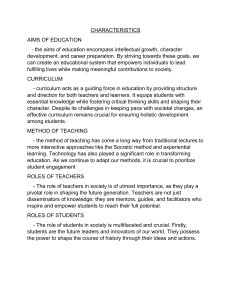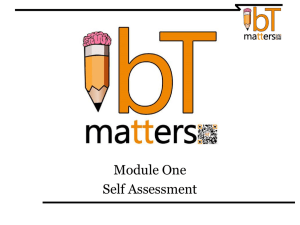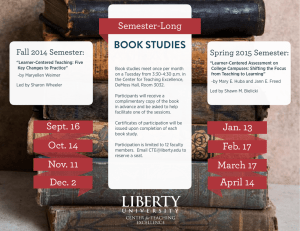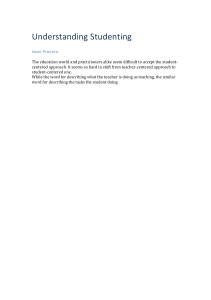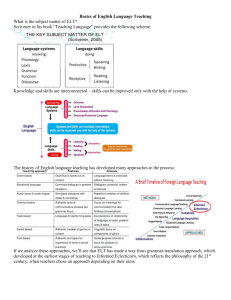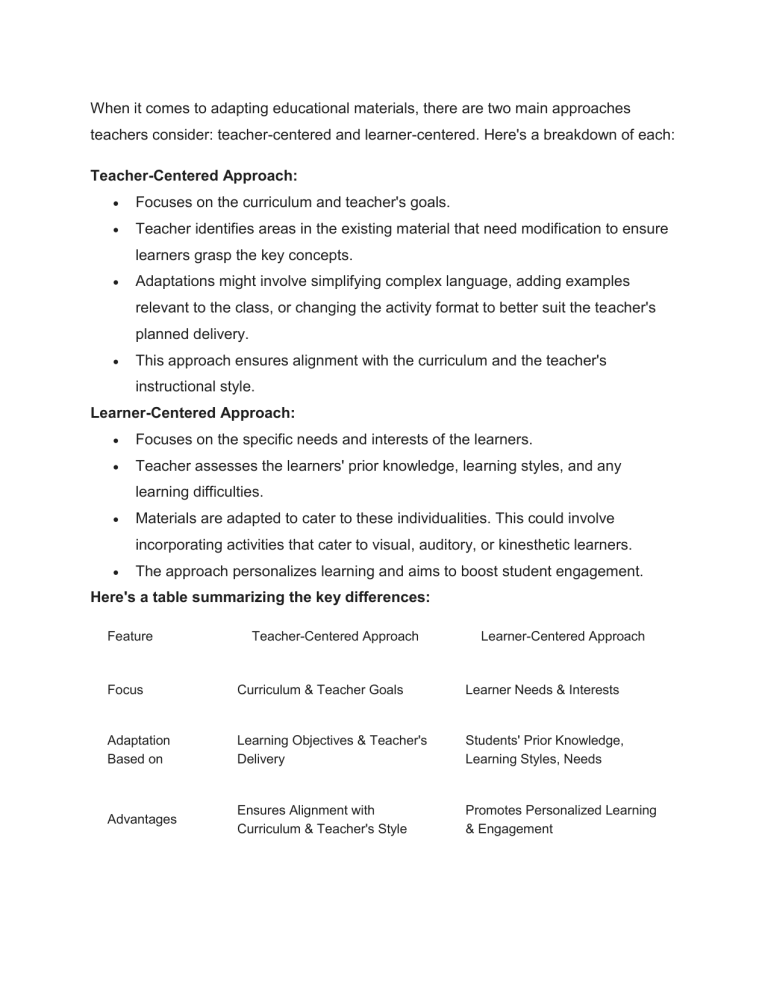
When it comes to adapting educational materials, there are two main approaches teachers consider: teacher-centered and learner-centered. Here's a breakdown of each: Teacher-Centered Approach: Focuses on the curriculum and teacher's goals. Teacher identifies areas in the existing material that need modification to ensure learners grasp the key concepts. Adaptations might involve simplifying complex language, adding examples relevant to the class, or changing the activity format to better suit the teacher's planned delivery. This approach ensures alignment with the curriculum and the teacher's instructional style. Learner-Centered Approach: Focuses on the specific needs and interests of the learners. Teacher assesses the learners' prior knowledge, learning styles, and any learning difficulties. Materials are adapted to cater to these individualities. This could involve incorporating activities that cater to visual, auditory, or kinesthetic learners. The approach personalizes learning and aims to boost student engagement. Here's a table summarizing the key differences: Feature Teacher-Centered Approach Learner-Centered Approach Focus Curriculum & Teacher Goals Learner Needs & Interests Adaptation Based on Learning Objectives & Teacher's Delivery Students' Prior Knowledge, Learning Styles, Needs Advantages Ensures Alignment with Curriculum & Teacher's Style Promotes Personalized Learning & Engagement In essence, the best approach often involves a blend of both. Teachers can consider the curriculum requirements while still finding ways to tailor the materials to make them more accessible and engaging for their students. The main difference between teacher-centered and learner-centered approaches boils down to who's in the driver's seat of the learning process. Teacher-Centered Approach (Traditional) Focus: The teacher is the main source of information. They lecture, demonstrate, and deliver the curriculum. Student Role: Students receive information passively, memorizing facts and completing assignments as directed. Activities: Lectures, teacher presentations, rote memorization, individual exercises. Classroom Environment: Tends to be quiet, with less student interaction. Learner-Centered Approach Focus: Students are actively involved in their learning. They explore, analyze, solve problems, and construct their own understanding. Teacher Role: The teacher acts as a facilitator, guide, and coach, creating a supportive environment for student learning. Activities: Group discussions, projects, simulations, research, presentations. Classroom Environment: More interactive and collaborative, with students working together and sharing ideas. Here's an analogy: In a teacher-centered classroom, the teacher is like a tour guide telling you everything there is to know about a place. In a learner-centered classroom, it's more like a guided exploration, where you're encouraged to discover things for yourself and ask questions. While learner-centered approaches are generally favored for promoting deeper understanding and critical thinking skills, there's still a place for teacher-centered methods in certain situations. The most effective teachers often use a blend of both approaches to tailor their instruction to the specific needs of their students. The main difference between teacher-centered and learner-centered approaches boils down to who's in the driver's seat for learning. Teacher-Centered Approach (Traditional) Teacher as the Sage on the Stage: The teacher lectures, transmits information, and delivers the curriculum. Students are expected to absorb the knowledge. Focus on Content Delivery: The emphasis is on covering a specific set of topics chosen by the teacher. Passive Learning: Students primarily listen and take notes. There's less opportunity for discussion or questioning. Assessment of Learning: The teacher evaluates how well students have memorized and regurgitated the information. Learner-Centered Approach Teacher as a Facilitator: The teacher guides and supports students in their learning journey, creating a more interactive environment. Focus on Skill Development: The goal is to equip students with critical thinking, problem-solving, and communication skills. Active Learning: Students engage with the material through discussions, projects, group work, and hands-on activities. Assessment of Learning: Evaluation focuses on a student's ability to apply knowledge, analyze information, and solve problems. Here's an analogy: Teacher-Centered: Imagine a teacher pouring knowledge from a jug into students' empty cups. Learner-Centered: Think of the teacher as a coach, helping students build their own wells of knowledge by providing them with the tools to dig and find water. In reality, most effective classrooms use a blend of both approaches. A teacher might start with a mini-lecture to introduce a concept, then transition to group activities where students explore it further. The main difference between teacher-centered and learner-centered approaches boils down to who's in the driver's seat for learning. Teacher-Centered Approach (Traditional) Focus: The teacher is the main source of information. Lessons are designed around what the teacher wants students to learn. Activities: Lectures, teacher presentations, memorization drills. Role of the Teacher: The "sage on the stage," delivering knowledge and ensuring students retain it. Role of the Learner: Passive recipient of information. Benefits: Can be efficient for conveying factual information, works well for large groups. Drawbacks: Doesn't encourage critical thinking or independent learning, may not cater to different learning styles. Learner-Centered Approach Focus: Students are actively involved in the learning process. Lessons are designed to address their interests and needs. Activities: Discussions, group projects, problem-solving tasks, student presentations. Role of the Teacher: A facilitator, guide, and coach, creating a supportive environment for student exploration and discovery. Role of the Learner: Actively engaged in learning, taking ownership of their understanding. Benefits: Promotes critical thinking, problem-solving, collaboration and communication skills, fosters a love of learning. Drawbacks: Can be more time-consuming to implement, may require more classroom management. In reality, most effective classrooms use a blend of both approaches. The teacher might start with a mini-lesson to introduce a concept (teacher-centered), then have students work on a project to apply that concept (learner-centered).
